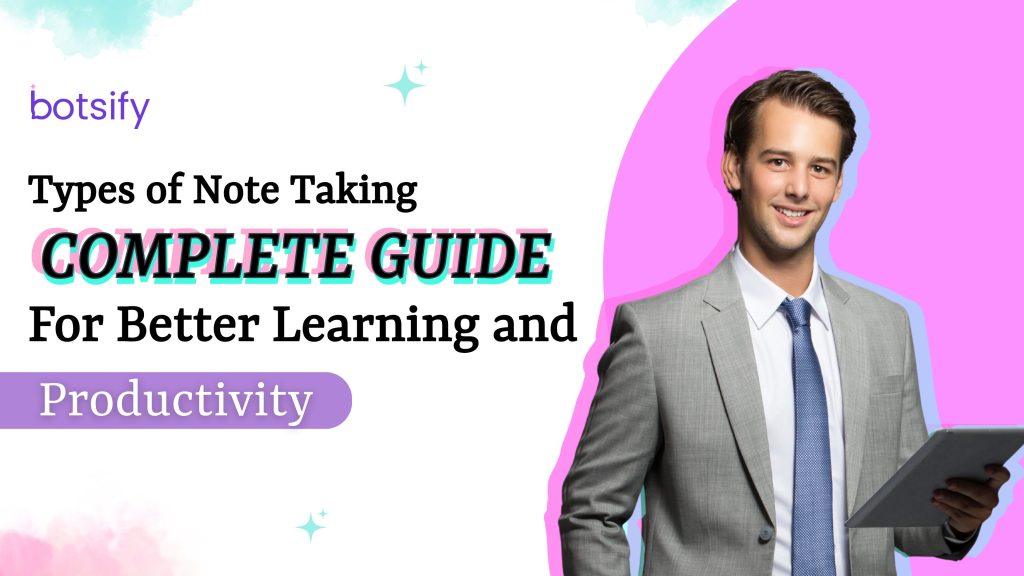Introduction
Have you ever found yourself attending a lecture or an important meeting, scribbling furiously, only to look back later and realize you barely remember what was said? You’re not alone. Good note-taking isn’t about recording every single word—it’s about capturing key ideas in a way that makes sense to you later.
Students and professionals alike recognize the value of effective note taking—recent studies show that individuals who regularly structure their notes achieve up to 13% higher test scores or professional outcomes compared to those who don’t take notes at all. Another survey found that 82% of office workers believe organized notes enhance team collaboration and reduce meeting time.
Understanding the different types of note taking can help you become a more effective learner and professional. Whether you’re a student, a manager, or someone just trying to keep track of your thoughts, choosing the right method can make all the difference in how well you remember and apply what you learn.
What Is Note Taking?
At its core, note taking is the process of actively listening or reading and summarizing important information in your own words. It’s more than just a record—it’s a tool that helps you engage with the material, organize ideas, and improve long-term retention.
When you explore different types of note taking, you’ll see that each method supports different learning styles. Some people need a visual map to understand concepts, while others thrive on structured outlines. By experimenting, you’ll discover the best fit for your brain.
Why Effective Note Taking Matters
Effective note taking has several benefits beyond simply writing things down. First, it improves your understanding and memory. By processing information as you record it, you’re more likely to remember it later. Research in classroom and corporate settings demonstrates that people recall nearly 34% more key points when those details are present in their notes [Source], versus just 5% when relying on memory alone [Source].
It also helps you organize complex information. Instead of trying to recall random points from memory, you’ll have a clear structure you can refer back to anytime—boosting confidence in exam settings or meetings.
Finally, taking good notes is directly linked to improved productivity. By consistently capturing and revisiting important details, professionals spend less time searching for information and more time acting on tasks.

Popular Types of Note Taking
Different situations call for different approaches. Here are some of the most widely used types of note taking:
- Outline Method: A logical, hierarchical format that breaks information into main topics and subtopics.
- Cornell Method: Divides the page into sections for notes, keywords (cues), and a summary.
- Mapping Method: Uses diagrams to connect ideas visually, similar to mind maps.
- Charting Method: Organizes information in columns and rows, perfect for comparisons.
- Sentence Method: Records information line by line, great for fast-paced discussions.
Outline Method
The outline method is one of the most traditional and popular techniques. You structure notes using headings and indents to show relationships between ideas.
Here’s a simple way to use it:
- Main topic
- Subtopic
- Supporting detail
- Supporting detail
- Subtopic
For example, if you’re taking notes on a marketing lecture, your main topic might be “Social Media Strategy,” subtopics might include “Content Planning,” “Analytics,” and so on.
The outline method works best for well-organized lectures or meetings with a clear agenda. It’s easy to scan and helps you see how ideas connect. However, it might not work as well for brainstorming or more chaotic discussions.
Portable AI Agents In Seconds, Use Everywhere
Prompt, Test, and Deploy AI Agents Across Social Platforms and LLMs. Automate Everything.
Cornell Method
The Cornell method is designed to encourage active review and reflection. The page is divided into three sections:
- Note-taking column (right side): Write down main notes during the lecture or meeting.
- Cues column (left side): Afterward, add keywords, prompts, or questions that help with review.
- Summary section (bottom): Summarize the main points in a few sentences.
This method is excellent for students and professionals alike because it forces you to process and revisit your notes instead of simply storing them away. It’s especially useful for subjects that require memorization, like science or law.
Mapping Method
The mapping method is perfect for visual learners and for subjects where ideas are interconnected. You start with a central concept in the middle of the page and draw branches outward for related subtopics and details.
For example, if you’re planning a project, the center might say “Project Launch,” with branches for “Marketing,” “Budget,” “Team Roles,” and so on.
This method is great for brainstorming, planning, and creative sessions where you need to see relationships between ideas quickly. However, it can get messy if not managed carefully and isn’t ideal for very detailed, linear information.
Charting Method
If you’re dealing with a lot of data or comparing different items, the charting method is your best friend. You create a table with columns for categories and fill in information as you go.
For example, in a business meeting, your columns might include “Project Name,” “Status,” “Owner,” and “Deadline.” As updates are shared, you simply fill in the table.
The main benefit is that it allows you to see patterns and differences at a glance. It’s ideal for tracking projects, recording research results, or reviewing multiple case studies side by side.
Sentence Method
The sentence method involves writing every new idea on a separate line, often as a full sentence or a brief phrase.
This approach works best in fast-paced lectures or meetings where information flows rapidly. Instead of worrying about structure, you focus on getting everything down as quickly as possible.
However, reviewing these notes later can be time-consuming because they lack organization. Many people choose to rework sentence-method notes into an outline afterward to make them easier to study or reference.
Choosing the Right Method
So, which type is right for you? It depends on several factors:
- Your learning style: Visual learners might prefer mapping; logical thinkers might love outlines.
- Content structure: If the material is highly structured, outlines or Cornell work best. For free-form discussions, mapping shines.
- Purpose: Use charting for comparisons, sentence method for speed, and Cornell if you want built-in review steps.
You can also combine methods. For example, use the sentence method during a meeting to quickly capture information, then convert your notes into an outline later for clarity.
Digital vs. Paper Note Taking
Technology has added new layers to note taking. Digital tools like OneNote, Evernote, and Notion allow for flexible formatting, easy sharing, and integration with other apps. Some tools even include audio recording and automatic transcription features.
On the other hand, paper notes have their own advantages. Writing by hand improves memory retention and can feel more personal and creative. Research supports that handwritten notes often lead to better recall than typed notes, especially for subjects requiring deep processing. [Source]
Ultimately, the choice depends on what feels most comfortable and helps you stay organized.
Conclusion
Understanding different types of note taking empowers you to choose the method that fits your brain, goals, and context. Whether you prefer a classic outline, a detailed Cornell layout, a mind map, a structured chart, or quick sentences, each technique has unique strengths.
Experiment, mix, and adapt until you find your perfect note taking style. With the right method, your notes can transform from scattered scribbles into powerful tools for learning and productivity.
FAQs
Which note taking method is best for students?
The Cornell method is often recommended because it combines structure with active review.
Can I use different methods for different subjects?
Absolutely! You can switch methods depending on the topic, context, and how the information is presented.
Is digital note taking better than handwritten?
Both have pros and cons. Digital notes are easy to organize and search, while handwritten notes can improve memory retention.
How do I review my notes effectively?
Schedule time to revisit and summarize your notes soon after the lecture or meeting to reinforce learning.
What if I take notes too slowly?
Practice summarizing key points instead of writing everything verbatim, or try abbreviations and symbols to speed things up.
AI Agentic Platform For Building Portable AI Agents
Say Hello To Agentic AI That Connects With Your CRM And Even Other Agents


